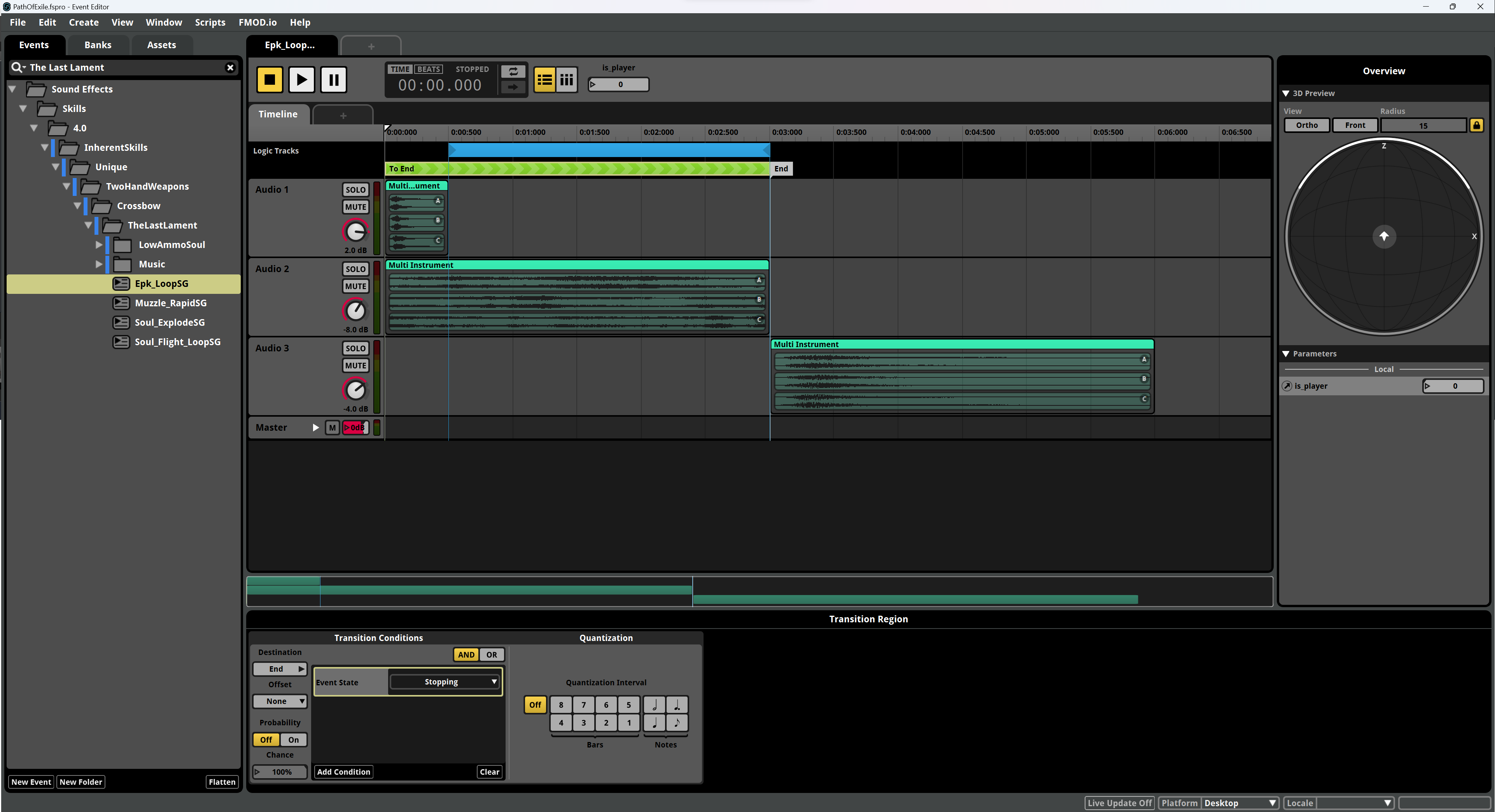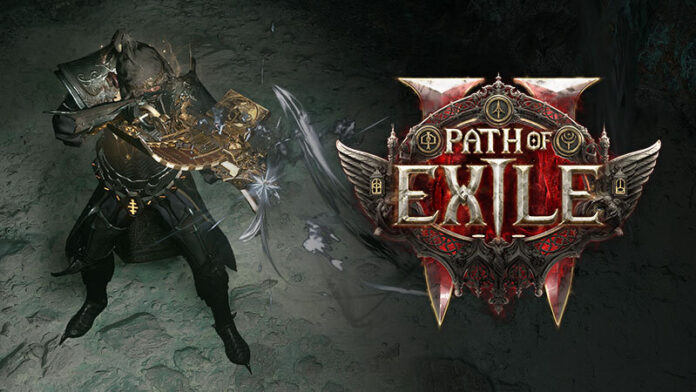Patch 0.2.1 for Path of Exile 2 introduced several new Unique Items, including the Last Lament. This Unique Crossbow quickly caught players’ attention—not just for its in-game power, but also for its distinctive visual design and unique sound. In this news post, our Senior Sound Designer Dominic dives into the process behind creating skill sound for the Last Lament.
——————————————————————————————————
Hi, I’m Dominic Downing, Senior Sound Designer at Grinding Gear Games. I joined the team at the start of 2020. Delirium was my first league I worked on, and I had to figure out joining the team mid-pandemic… it was a wild time! These days, I handle skill and combat audio for Path of Exile alongside another talented sound designer.
In this post, I’ll take you behind the scenes of skill audio design in Path of Exile 2, from concept to implementation.
Skills are part of the core of Path of Exile’s gameplay, and sound plays a huge role in reinforcing what they do and how they feel. A well-designed skill sound can signal danger, enhance impact, or even invoke safety. For example, a player casting Detonate Dead shouldn’t sound as threatening to the player as a monster with the Detonate Dead rare monster modifier; you need to feel the difference.
We work closely with designers and animators to understand what a skill does, its damage type, area of effect, whether it does damage over time, offers utility, and so on. Since we use our own engine, we are easily able to work with programmers to build or improve systems for audio integration. It’s a very collaborative process. Some examples: being able to tell if a grenade is in the air, rolling, or bouncing, or if a skill is going to repeat in quick succession because of another in-game mechanic, like Barrage. It’s also important to test each skill in-game with a variety of character builds to ensure the audio holds up in all kinds of scenarios.
Most of our sounds are a blend of recorded Foley (sometimes even our voices), library assets, and synthesis. For things like vocal layers, cloth movement, or rocks, we can easily jump into the sound booth to record unique elements. It’s a lot of fun and a great excuse to be a bit crazy without judgment!
Synthesis is a fun and powerful way to create sounds, and I often use my Eurorack setup for this. Eurorack is a form of modular synthesis that lets you build a synth or sound from the ground up. Using white noise and creative filtering, modulated with Erica Synths’ Joystick 2, I can produce movement of the sound for each skill, creating some of the windy textures you’ll hear in some of the wind skills. Modules like Schlappi Engineering’s 100 Grit and Make Noise’s Wogglebug are perfect for creating noisy, electrical textures, great for lightning-based skills. And for tonal, bell-like sounds, ideal for elemental magic, I often turn to the Rings module from Mutable Instruments. Recording weird, unexpected sounds like these is honestly one of the best parts of the job.
You don’t know how a sound works until it’s in the game. As I mentioned earlier, we test skills early on, across different builds, areas, and support gems. Randomisation and layering help keep sounds fresh and immersive. But getting sounds into the game as soon as possible during development is key. This way, we catch issues early and avoid spending too much time polishing something that doesn’t fit with gameplay. It’s better to create quick drafts, test them in-game, and make small tweaks than to perfect something upfront, only to discover major changes are needed later. We also have to manage technical limits like voice count (which is the maximum amount of sounds that can play at any time) and cooldowns (which is how soon a sound can play again after already playing). For example, if a skill fires multiple projectiles with the same sounds playing simultaneously, we need to make sure the audio doesn’t overload or cut out. And when you’re playing in a party, we consider how skill sounds affect other players; should your skill sound just as epic to them as it does to you?
We use FMOD, plus internal tools bespoke to Path of Exile. Over time, these tools have evolved based on direct feedback. I’ll think, “man, I wish I could just do X”, and our programming teams will make it a reality. It’s a dream!
Combat in Path of Exile can be a ruckus, so we always ask: what’s most important for the player to hear? Audio needs to guide, not overwhelm. We balance sounds through mixing, making sure everything fits together without getting too loud or quiet. We use a technique called ‘ducking’ to lower less important sounds, so key sounds stand out. Distance attenuation makes sounds quieter as they get farther away, helping create a sense of space. And priority systems decide which sounds get played or heard first when many happen at once, so players don’t miss critical cues like danger.
The Last Lament, a unique crossbow we introduced in the 0.2.1 patch for Path of Exile 2, adds melodic tonal elements to combat, which is something we normally try to very explicitly avoid. Musical sounds can easily clash with the game’s music or get tiring over time. But The Last Lament is a bit of an exception. The crossbow 3D model itself resembles a musical instrument, and based on the nature of the lore behind this item, we wanted to make this one special and create room within the soundscape to support it.
There’s a haunting, gothic, and musical theme baked into the core identity of The Last Lament. Its inherent skill, Compose Requiem, fires soul-like projectiles that explode on impact, accompanied by operatic voices and subtle musical layers. The goal was to make the shots feel sorrowful and haunting, reflecting the eternal anguish within the weapon, while keeping them musical to match the weapon’s identity, without compromising gameplay clarity.
The base shot needed to feel familiar, like the other crossbows, so it wouldn’t sound weaker or stronger than it actually is. I reused some of the usual crossbow layers like real crossbow recordings, gunshot tails, and cannon transients (they’ve got a nice pop to them). Then I layered in ghostly whispers, short screams, resonant metallic creaks, string-like hits, and some distant musical textures. I wanted it to feel musical, but not in a cheesy music box kind of way.
Michael Collier, one of our talented composers, helped here by sourcing some harpsichord notes, with subtle organ and kannel underneath. They play in a 3/4 rhythm, and the tempo shifts slightly based on your attack speed.
For the processing side of things, I kept it pretty simple in Reaper (my choice of digital audio workstation). Saturation was great for adding grit to the impacts, and I used pitch and frequency shifting to shape the tone and weight of each layer. Frequency shifting moves all frequencies by the same amount, ignoring their harmonic relationship, while pitch shifting preserves it. Saturation also adds harmonics, which gives sounds a textured, warm and often gritty feel. EQ was used to clean things up, cut unwanted frequencies, and boost the ones I wanted more of. A stereo imaging plugin helped widen the sound and make it feel a bit more epic, and some light compression kept the overall loudness balanced. That was pretty much it.
One of Compose Requiem’s earlier prototypes was a more note-heavy concept. We experimented with different musical approaches, but we realised the fire rate was just too fast, and gameplay is simply too chaotic for that kind of musical structure.
With the deadline creeping up, we pivoted. That’s when the idea of operatic souls escaping with each shot came up, which later influenced the unique’s lore too. We tried placeholder singing samples that triggered randomly. This was better, but still too much. In the end, with help from our gameplay programming team, we set up a system using a simple boolean parameter to only play a more finely crafted vocal while actively firing instead of it playing on each shot (which in the end does actually have subtle notes). That nailed it.
FMOD is the audio middleware we use to connect sound design to gameplay. It lets us control how and when sounds play, and adds variety, layering, and dynamics so things feel responsive and alive.
For Compose Requiem, the base shot and the musical notes are separate sounds. The shots have pitch and gain modulation to keep things varied and immersive, while the notes only have gain modulation since pitching the notes would throw them out of key with the music bed and vocals.
Early in development, to keep Compose Requiem’s melody from feeling repetitive, I created 16 sound events in FMOD. Each event plays a unique six-note sequence forming its own melody that sits over the skill’s music bed. When the crossbow fires, it triggers an event that uses a counter parameter with values from 1 to 16. Each value selects one of the 16 melodies to play in sequence. Within the event, command instruments trigger these melodies based on the counter’s value. There’s also a secret seventh instrument inside each melody’s playlist, a multi-instrument that instantly changes the counter to a new random value (between 1 and 16, but excluding the current one). This setup keeps the music flowing smoothly and fresh by randomly switching between melodies without repeating.
Since the skill has a fixed 12-second duration, we didn’t need to loop anything (a looping audio asset is an audio clip that seamlessly repeats). When it’s active, the game mutes all other music except what’s triggered by the crossbow. Often, skills are affected by various modifiers, and their duration can vary. This is when we would find ourselves using looping audio so it can start and stop whenever necessary.
Upon activating Compose Requiem, a visual soul-like burst with ghostly flames appears on the crossbow. I made a short activation sound to match, like the souls are trying to escape. This is followed by looping audio that lingers while the skill is active, sort of like the spirits are watching or peering through a door. At the end, it fades out with a subtle release sound. It’s all handled in one FMOD event using a loop region and a transition region. When the visual effect is deleted in-game, the event starts stopping, which triggers the transition to an “end” marker where the fade-out plays.
The soul projectiles you fire are set up pretty simply. The initial shot has some soul-like layers, but I added looping audio while they’re flying through the air, plus an impact explosion made up of vocal textures, debris, and various thick impacts. These have pitch and gain modulation, distance attenuation, and some Doppler on the loops.
Once everything’s hooked up, I go in-game and do a mixing pass, mostly balancing loudness and tweaking how big or small things feel, as well as what is important to the player and maybe not so important to potential party members. Sometimes this means going back and editing the original assets. I make sure to test in all kinds of contexts like early-game, late-game, and stupidly juiced maps so it always feels right, no matter how you’re playing. It’s so important to understand the game you’re working on in and out.
Ultimately, the sound design for The Last Lament didn’t need to happen, but the item itself was screaming for some special attention. The goal was to make it feel as special as possible without pulling the player out of the world. Throughout experimentation and design, we constantly focused on serving gameplay first. It doesn’t matter how cool something sounds; if it gets in the way of a player winning at Path of Exile, then it’s not actually that cool.
Most of my decisions are shaped by my experience playing the game. No matter how weird or musical it got, it still had to find its place in Path of Exile and, most importantly, serve the player. This is a philosophy that I see every day at Grinding Gear Games, and I’m proud to work on such an awesome game with amazing people.
Every sound in Path of Exile needs to have a clear purpose. If it doesn’t, it just ends up as noise cluttering the experience. One big lesson I’ve learned is that instead of always trying to make the big sounds bigger, it’s often more powerful to make the smaller sounds more subtle. That contrast is what really makes the impacts hit.
Working on Path of Exile is an honour. It’s a game I’ve loved for years, and I still play it after work. Next time you’re running a map, listen closely, there’s a whole lot going on under the hood!
続きを見る
🧠 編集部の感想:
パスオブエクスイル2の新アイテム「ザ・ラスト・ラメント」のサウンドデザインについての深掘りが印象的です。音の役割がゲームプレイの体験を強化することに特化しており、特に癒しと悲しみの要素が巧みに組み込まれています。このような細やかな工夫が、プレイヤーに独自の感情を持たせる要因となっていて、ゲームの魅力が一層増しています。
Views: 1


